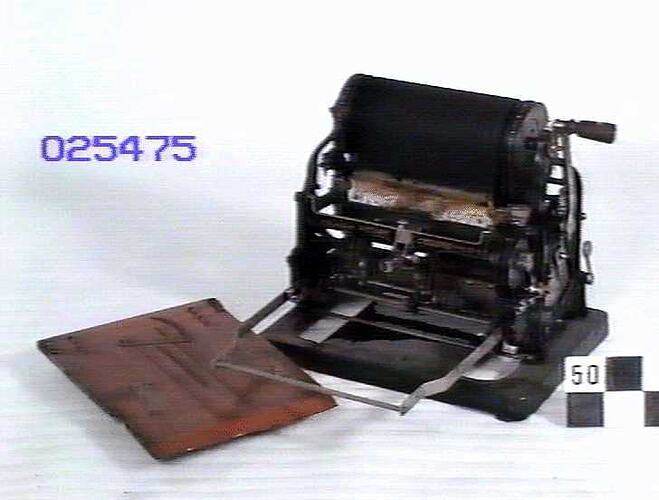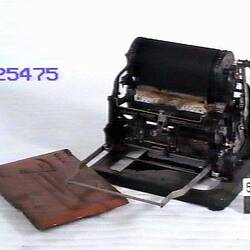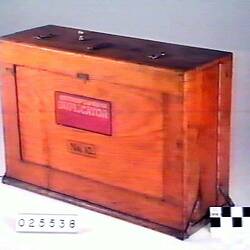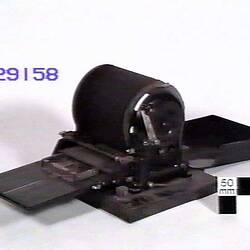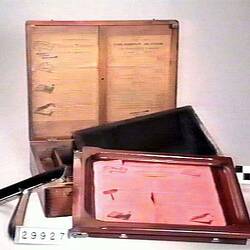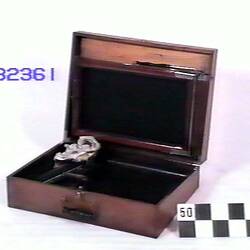Dead medium: The Copy Press, the Hektograph, Edison's Electric Pen, Zuccato's Trypograph, Gestetner's Cyclostyle, Dick-Edison Mimeograph, the Gammeter aka Multigraph, the Varityper, the IBM Selectric
Desktop Publishing is a phenomenon of the late 20th century. Modern products have made it possible for any office staff to produce material that looks professionally printed. However, office managers have had other kinds of small-scale publishing methods available to them for more than a century.
The words used to describe them were more modest, of course. At first, they talked about office 'copying,' and later they called it 'duplicating.' Only today, with computers, coupled with high-definition laser output has the technology grown up enough to earn the term 'Desktop Publishing.'
Desktop Publishing's first century began in 1856, when British chemist William Perkins discovered the first synthetic dye, aniline purple. This dye pointed the way to a wide range of new inks, including 'copying ink' used in the first practical method of reproducing business documents. An original written with copying ink was placed against a moistened sheet of tissue, the two were pressed together in a massive iron press, and a copy would appear on the tissue. Since the copy was backwards, the tissue had to be held up to the light to be read. The copy press became a fixture in every Victorian office. Today, they are sold in antique shops as 'book presses,' their true function long forgotten.
Aniline dyes also made another copying process possible. It was invented during the 1870s, and although it was sold under many brand names, generically it was known as the 'hektograph.' The device used a stiff gelatin pad coupled with special hektographic ink made with aniline dye. A document written with the ink was pressed to the pad. The gelatin absorbed the ink after a few minutes, and the original was removed. Blank sheets were then pressed against the pad, and the gelatin released a little of the ink each time, producing a positive copy. The hektograph was good for about 50 copies. 20th-century spirit duplicators (such as 'Ditto') were a later outgrowth of the hektograph and much easier to use.
About the same time as the invention of the hektograph, the first stencil duplicators began to appear. These used various devices to perforate waxed tissue paper, creating stencils through which ink could be passed. The first of these was Thomas Edison's Electric Pen of 1876. This gadget used current to vibrate the point of a stylus, creating tiny holes in the stencil to form the image. A simpler solution came from Eugenio Zuccato who invented the Trypograph in London in 1877. Zuccato put his stencil on the surface of an iron file. When he wrote with a plain stylus, the rough file surface punctured the stencil from below. Edison obtained a U.S. patent for a similar process in 1880, although he did nothing with it for several years. In 1881, David Gestetner, working in England, invented another simple stencil perforator. Known as the Cyclostyle, it was a pen with a miniature toothed wheel on the end. By writing on the stencil, the wheel rolled along and punched tiny perforations in the sheet.
The last major player to enter the stencil game was A.B. Dick of Chicago. Dick was a lumber merchant who needed a way to duplicate the often-needed inventory lists in his business. Experimenting on his own in 1884, he came up with a file-plate stencil process similar to Zuccato's and Edison's, but more practical. Dick saw real market potential in the product and applied for a patent only to find that Edison had beaten him to it. Dick contacted Edison, and proposed the idea of selling the device to the public. Dick's most brilliant idea in the venture, however, was not the invention itself, but his plan to use Edison's name on the label! Edison's name had true star quality in the 1880s. Dick coupled it with an intriguing brand-name taken from the Greek, and in 1887 the Edison 'Mimeograph' duplicator was born.
For several years the Mimeograph and Cyclostyle duplicators coexisted, each performing the same function using their slightly different methods. With each, finished stencils were placed in a wooden frame so that ink could be pressed through them with a roller. It was messy but effective. At this earliest stage, however, neither device effectively exploited the Typewriter, another new invention which seemed perfectly suited to be teamed with duplicators. The Typewriter had been around for about ten years when the Mimeograph and Cyclostyle appeared. Duplicator stencils, however, were backed with thin tissue which was often torn to pieces under the pounding of typewriters. A.B. Dick pounced on the solution to the problem when he bought rights to an 1888 patent for a new stencil backed by a sturdy porous tissue. The typewriter would penetrate the wax, but not the tissue. Suddenly, the potential for producing thousands of copies from a typewritten original was created.
In 1891, Gestetner helped the technology along another step, by creating an 'automatic' printing device, which worked much faster than the old manual wooden frame. A rivalry between Dick and Gestetner might have developed, but instead, their relationship was cordial. In 1893 they agreed to share patents, each using the typewriter stencil and the automatic printer in his own products, and each prospering in the process.
The turn of the century brought the development of rotary stencil machines, which meant that copies could finally be 'cranked out' in the literal sense. A.B. Dick's version of this device was a single drum model with ink inside the drum and forced directly through the stencil. Gestetner marketed a double-drum design, inking the stencil with rollers, which picked up the ink from a tube. Other manufacturers introduced their own models, but for years the two principal names in the industry were Mimeograph from Dick and Cyclostyle from Gestetner.
As stencil duplicators developed for long runs, carbon paper began to replace the copy press for short runs. Carbon paper was invented in 1806, but was not practical for making copies written with the light pressure of pen and ink. Typewriters changed the situation. Copying with carbons was called 'manifolding', and some typewriters were sold claiming the ability to make up to 25 carbon copies at once!
An alternative duplicating method for very long runs became available after the turn of the century in a device called the Gammeter or Multigraph. This was actually a small rotary printing press, with grooves in its cylinder allowing type to be easily set on the surface. Setting the type took more work than producing a stencil, of course, so the Multigraph's use was limited.
The 20th century brought other new potentials to 'office duplicating' advancing it considerably toward 'desktop publishing.' Among the new devices was the Vari-Typer, an evolved form of the old Hammond Typewriter, which had been on the market since 1884. The Hammond was distinctive in that it typed with a single type element, a simple curved strip which could be quickly changed for a variety of typestyles. In the 1920s Hammond added variable pitch to its machines, making typestyles in widely different sizes practical for the same machine. Later, the Hammond was renamed Vari-Typer, and the Ralph Coxhead Corporation took it over.
The Vari-Typer was electrified and equipped with differential spacing and line justification. Lines were justified by typing them twice. The first typing determined the number of letters on the line, which was set on a dial. This altered the word spacing to align the right margin for the second typing. No longer was this machine called a typewriter. It was known as a cold typesetter, and Vari-Typers using the basic Hammond design were in production until the 1970s. The Vari-Typer could be used to type Mimeograph stencils, although this was a bit cumbersome. Much easier was its use with photo-lithography, which appeared in the 1930s. As today, an original was created on plain paper, and a litho plate was produced from it by photography. Back then it was not as easy as it is today, but the concept was the same.
Special materials were also available allowing the original to be typed directly on a thin, flexible printing plate. Thousands of copies could be printed on a small offset printing press from a Vari-Typer original. Such devices were used to produce the surrender documents signed by Japan aboard the Battleship Missouri at the end of World War II.
The combination of typewriters, Vari-typers, Mimeographs, Multigraphs, offset litho machines and spirit duplicators carried our developing desktop publishing technology through to the end of its first century in 1956. Electrostatic copying, which first appeared in 1938, was just beginning to make a big impact as the 1960s approached. 'Xerox' was starting to become a household word, but high-volume plain paper copiers would take a while to become the inexpensive fixtures they are today.
In 1956 computers had not reached desktop publishing capability, and the instant print shop was still years away. The Vari-Typer, however, would soon find a competitor in IBM's Selectric Typewriter, introduced in 1960, and later available in typesetting versions with all the features offered by Vari-Typers.
The first century of desktop publishing offered tremendous progress for people who wanted to turn out printed material on a small scale. However, the second century so far has been nothing less than amazing. Who, after all, would have ever dreamed that an entire publication could be written, edited, typeset and composed before even the first drop of ink was applied to the first piece of paper?
Early Typewriter Collector's Association
2591 Military Ave.
LA, CA 90064
USA
([email protected])
More Information
-
Keywords
-
Authors
-
Article types
